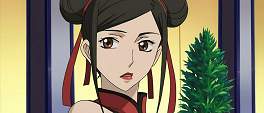

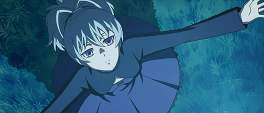
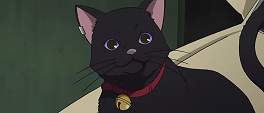
Darker than Black presents itself in shades of grey: muted morality and subtle story-telling; it built itself the enviable position of being as complex and involving as you allow it to be, peeling back layer upon layer if you care to look. Unfortunately the series falls short of perfection and in its quest to provide a softly-spoken and adult narrative, it omits to fill in some of the most glaring blanks and leaves some ideas stranded out at sea.
The hyperbole uttered in the first few minutes is easy to dismiss given the script's staunch refusal to repeat itself
Born from Tensai Okamura, animated by the creative powerhouse, BONES and scored by the seminal Yoko Kanno, Darker than Black was one of those projects gifted with immensely talented people and a head-start on becoming a classic. It arguable fails to achieve that illustrious title shared by so many other BONES productions but only through what it lacks rather than what it has in abundance.
Read the rest of this entry


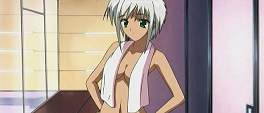

Soul Link is absolute, unmitigated dross. It fails on all levels to entertain, engage, or even hold interest beyond the few minutes of morbid curiosity it takes to realise what uninspiring mediocrity it is. It has neither the aesthetics, the intelligence or the big names to let the series be even passable and each episode ends up being twenty minutes of utter drivel where one feels they've lost far more than they've gained by watching it.
overlooking the fact that a hardened terrorist organisation employs a diminutive, top-heavy girl in hot-pants
Liberally adapted from an erotic visual novel by Navel, Soul Link doesn't even have the decency to integrate fan-service or any kind of racy content; the best the bargain-basement visuals can come up with is the leather-clad dominatrix masquerading as an antagonist and a mercenary with breasts which look like they've been badly modelled after a Madonna video. With no naughtiness in sight, the series is left to scratch around in the dirt and try and come up with some kind of manufactured drama which, ultimately, the characters are too incompetent to do anything about.
Read the rest of this entry




It's hard to know where to begin with Zero no Tsukaima: whether to start by gutting the laughable excuse for a plot, perhaps castigating the clockwork collection of characters, or perhaps even starting on the atrociously simplistic animation and aesthetics. From all of this one could be certain that it is a show without merit, and while critically that is true, there are several aspects which I'm sure could make this a guilty pleasure for a select few.
the alarming regularity at which seemingly uninvolved characters turn up on supposedly secret outings
Based off a series of light novels by the same author as "Green Green", Noboru Yamaguchi, and produced by JC Staff, the series has penalties before it even begins. The first episode does nothing to allay these worries and produces cliché after cliché in both characters and plot. The protagonist is a failing mage called Louise who summons an affable idiot from modern day Japan into Tristein Magic Academy; already it is fighting against other "fish out of water" anime and the obvious inspiration from Harry Potter. The rest of the series carries on regardless and stumbles through hackneyed and quickly ignored plot points and culminates in a poorly orchestrated and wholly expected "battle" intermingled with predictable character hook-ups.
Read the rest of this entry
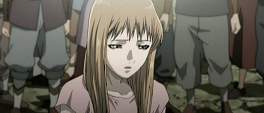
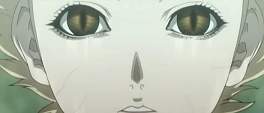
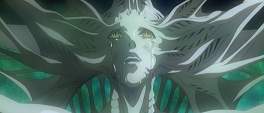
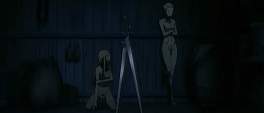
Claymore's hook is the presence of blonde, nubile young ladies with the titular, impossibly large swords set in a fantastical, medieval world. Being able to move past this premise is the first of many things that this series manages to do well, unfortunately it is marred by a plethora of other niggling problems which turn what could have been a great series into one that, overall, is lamentably mediocre.
Putting more than twenty slim, blonde females into a dark and snowy mountain town probably sounded a lot better on paper
Claymore goes wrong by being indecisive as to what it is trying to be and what it is trying to convey. The lithe girls with swords bait is more or less ignored from the outset with a surprising lack of fan-service and obvious lesbian undertones; this creates a problem with what is essentially a shounen series. The "monster of the week" cliché is dispatched with swiftly and a story unravels which thrusts the protagonist, Clare, from one hopeless battle to the next. Neither the story nor the characters are enough to carry this off, its one saving grace is the speed at which the story moves. Not so much adapted, but lifted straight from the manga, the series works on a "one episode, one chapter" progression which means otherwise tedious story elements and swiftly dealt with and otherwise enjoyable combat set-pieces drag on far too long.
Read the rest of this entry




It's hard to describe Lucky Star without using words such as "meta" or "proto", or comparing it to similar all-female high-school comedies such as Azumanga Daioh or School Rumble or perhaps drifting into expletives about the circular Suzumiya Haruhi references by Kyoto Animation. The concept to take away from Lucky Star is that it is relevant to compare it to all of these things, and brutally unfair.
some of the late-to-the-party characters seem ignored compared to the tried and tested Kagami x Konata tiffs
Lucky Star shines because it manages to not so much parody but lampoon modern otaku and anime by, paradoxically, being a fan pandering anime itself. The first episode was divisive in that many wrote off the long soliloquies as boring or blatantly obvious as to their purpose, this weaned off the Haruhi refugees like a brick wall. In retrospect the meandering script changed little in delivery or tone from the last episode to the first episode, unlike the aesthetics which, while universally well animated, showed how much the animators settled in to drawing the characters. The first episode did brilliantly in laying down the foundation of the rest of the series, characters were expanded upon and new ones introduced, but the humour and pacing remained.
Read the rest of this entry



















